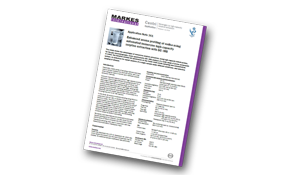This study from Markes International shows the advantages of immersive sorptive extraction, using high-capacity HiSorb probes, for the gas chromatography–mass spectrometry (GC–MS) analysis of a wide range of aroma compounds in vodka.
 Introduction
Introduction
Historically, a wide variety of sampling methods have been used to extract volatiles from alcoholic spirits, with a key driver being the need to improve upon inefficient solvent extraction methods. In this study, immersive sampling using HiSorb is employed in conjunction with GC–MS, to identify a range of VOCs and SVOCs in vodka. The entire process of sampling and trap-based analyte preconcentration is automated by the Centri® system from Markes International. The numerous advantages of this approach for analysts tasked with investigating aroma profiles of spirits are shown. These include detecting analytes across a wide volatility range, extending dynamic range by varying the split ratio, and eliminating problems caused by ethanol overloading.
It is shown how these features are enhanced by automated sample splitting and re-collection, and how the performance of HiSorb compares very favourably to static headspace sampling, where it is used here in conjunction with trap-based preconcentration (‘headspace–trap’).
Background to Centri and HiSorb/Markes/Apps_eDM_July2019/Centri.png) The Centri® system from Markes International is the first GC–MS sample prep platform to offer high-sensitivity unattended sampling and preconcentration of VOCs and SVOCs in solid, liquid and gaseous samples.
The Centri® system from Markes International is the first GC–MS sample prep platform to offer high-sensitivity unattended sampling and preconcentration of VOCs and SVOCs in solid, liquid and gaseous samples.
Centri allows full automation of sampling using HiSorb high-capacity sorptive extraction, headspace, SPME, and tube-based thermal desorption. Leading robotics and analyte-trapping technologies are used to improve sample throughput and maximise sensitivity for a range of applications.
In addition, Centri allows samples from any injection mode to be split and re‑collected onto clean sorbent tubes, avoiding the need to repeat lengthy sample extraction procedures and improving security for valuable samples, amongst many other benefits.
Conclusion
In conclusion, immersive high-capacity sorptive extraction has been shown to be a very efficient sampling technique for a wide range of aroma compounds in an alcoholic spirit. A key feature is that HiSorb probes, as well as being robust and re-usable, have a large volume of PDMS phase that results in much higher responses for important higher-boiling compounds than is possible using headspace (even when coupled with trap-based focusing).




